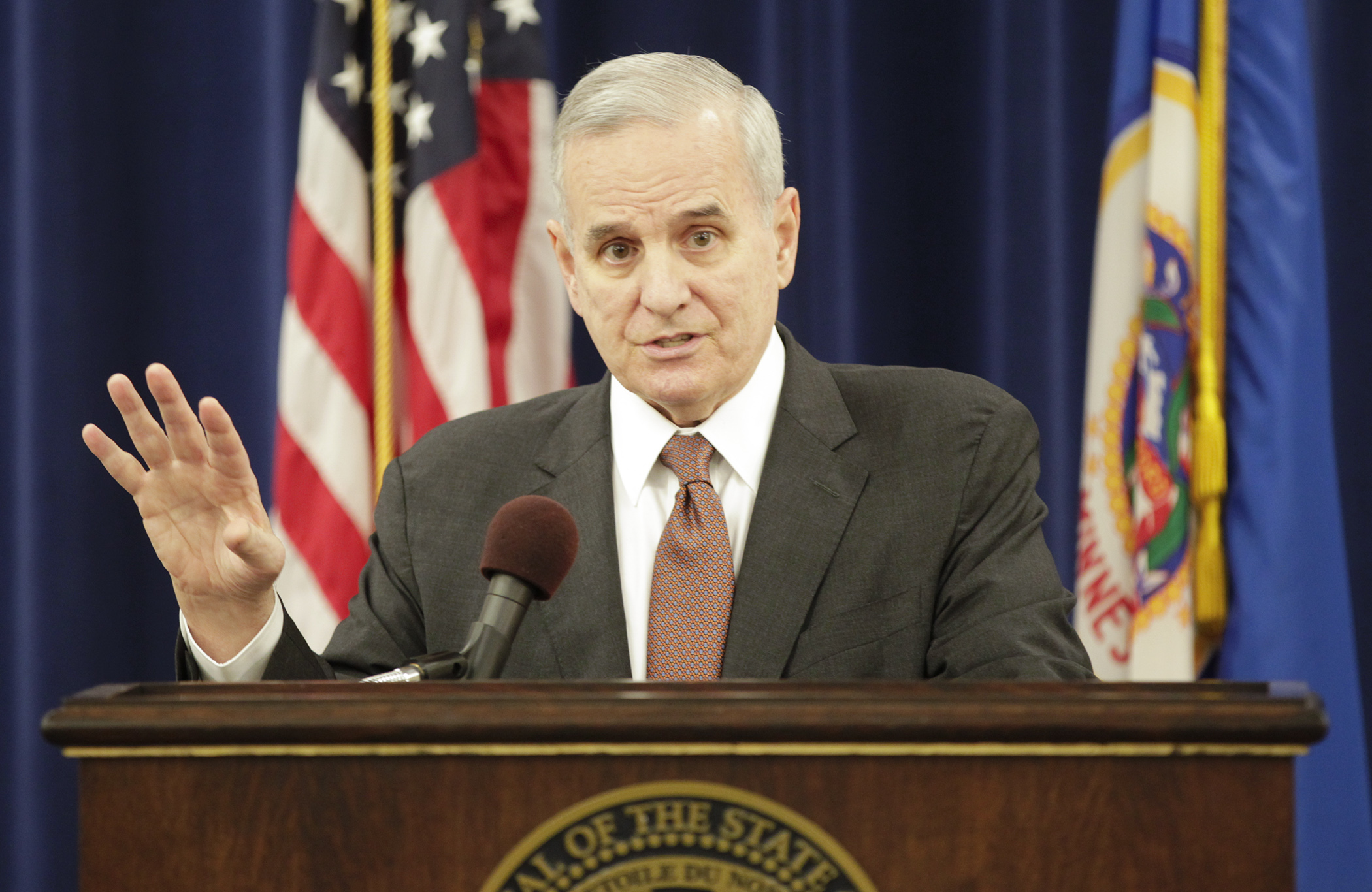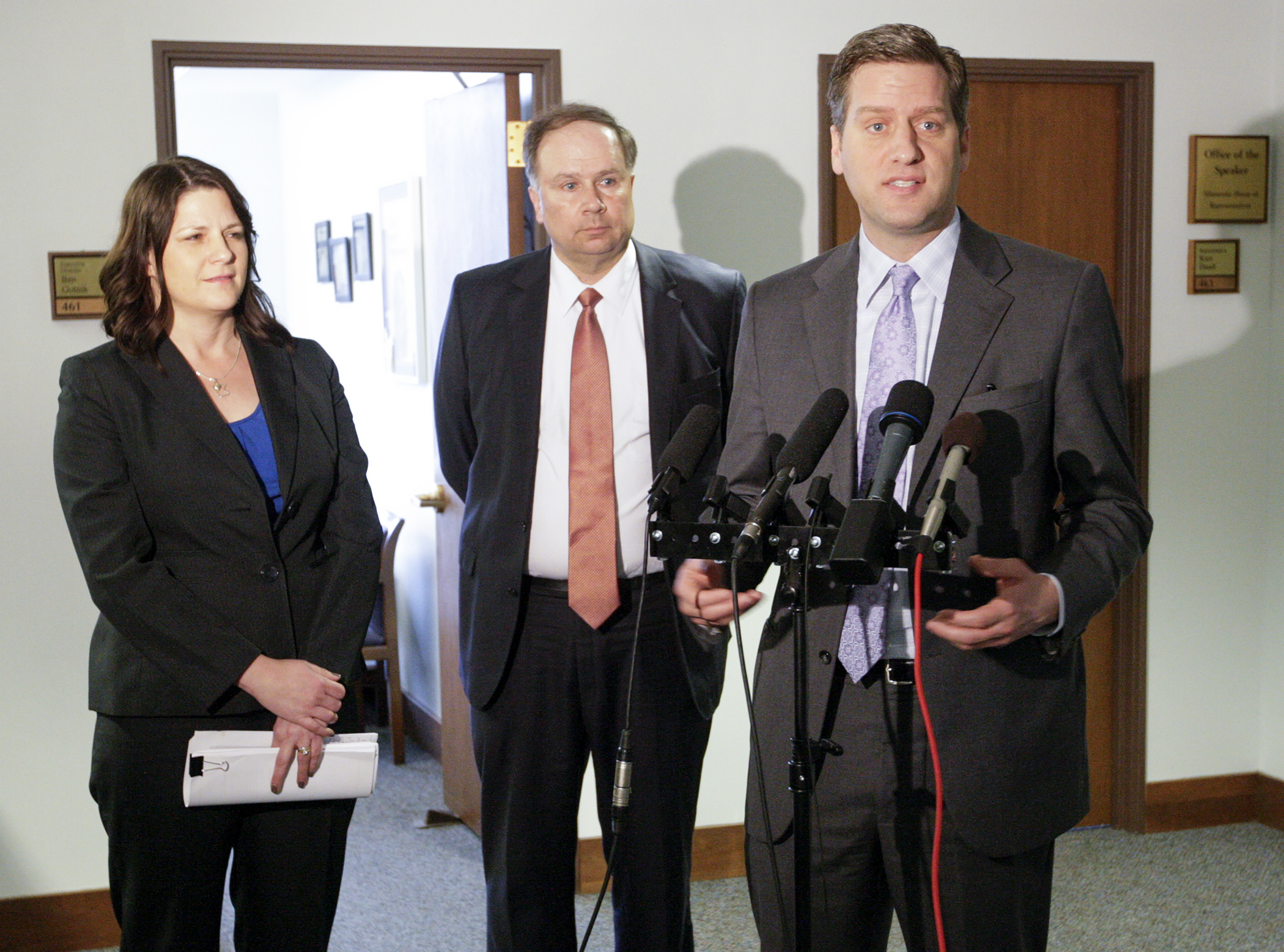Governor: supplemental budget protects state’s fiscal future

(Updated with video)
Urging fiscal caution to protect Minnesota against an uncertain economic future, Gov. Mark Dayton released his supplemental budget proposal Tuesday, featuring a mix of spending increases, tax cuts and $200 million left on the bottom line to guard against a potential economic downturn.
“Lt. Gov. Smith and I are proposing a fiscally responsible supplemental budget that would protect our state government’s fiscal integrity while making critical investments in a state that’s better for all Minnesotans,” Dayton said.
The governor said his budget, which would spend $698 million of the projected $900 million surplus available during the current biennium, prioritizes investments in Minnesota’s children, families and communities as well as providing tax cuts for middle-income families.
His proposal includes $100 million to increase broadband access in Greater Minnesota, $25 million to make voluntary prekindergarten available to 3,700 additional 4-year-olds, a gasoline tax to increase transportation funding and tax cuts he said will benefit more than 400,000 families.
Dayton said he was committed to ensuring the state did not fall back into the “fiscal mess” it was in when he took office.
“Our supplemental budget would leave $571 million of projected surplus unspent and unobligated at the end of the next biennium,” Dayton said. “Combined with a budgetary reserve fund of $1.6 billion, we provide over $2 billion of protection from a future national economic downturns.”
 House Speaker Kurt Daudt, right, responds to the release of Gov. Mark Dayton’s supplemental budget outside his office along March 15 with House Majority Leader Joyce Peppin and House ways and Means Committee Chair Jim Knoblach. Photo by Paul Battaglia
House Speaker Kurt Daudt, right, responds to the release of Gov. Mark Dayton’s supplemental budget outside his office along March 15 with House Majority Leader Joyce Peppin and House ways and Means Committee Chair Jim Knoblach. Photo by Paul BattagliaWATCH Full video of the governor's supplemental budget announcement on YouTube
The governor’s budget proposal comes on the heels of Minnesota Management & Budget’s February forecast, which projected a $900 million budget surplus for 2016-17, down from November’s forecast of $1.2 billion mostly due to slower-than-expected growth in income and sales tax collections. Dayton also said he’d recently attended a National Governors Association meeting where several economists predicted “the strong likelihood of a national recession by calendar 2018.”
House Speaker Kurt Daudt (R-Crown) said Dayton’s budget proposal doesn’t do enough to provide tax relief for Minnesotans, and called aspects of the budget concerning.
“When Minnesotans find out the governor is actually proposing another $900 million per year of tax increases at a time when we’ve got a $900 million surplus, Minnesotans are going to be pretty disappointed,” Daudt said. “On top of that, he’s proposing to spend about $7 for every $1 he’s giving back in tax relief – obviously out of whack with what I think Minnesotans’ expectations are.”
House Minority Leader Paul Thissen (DFL-Mpls) praised the budget proposal in a statement, saying the governor had “wisely protected” the state’s financial future.
Broadband
Dayton’s $100 million appropriation for the Border-to-Border Broadband Grant Program would be used to build infrastructure that promotes expansion of broadband service to areas of the state that either don’t have it, or are underserved. The state estimates there are currently 244,000 Minnesotans with no access to broadband.
Prekindergarten
The proposal to fund prekindergarten would require school districts and charter schools offering prekindergarten programming to provide at least 350 hours of instruction each school year. Funding would be divided between urban, suburban and Greater Minnesota school districts, and charter schools.
Transportation
Dayton’s call for a major investment in transportation funding would bridge what he said is an estimated $6 billion gap between funding needs and revenues over the next decade. That investment would be paid for with a 6.5 percent gross receipts tax on gasoline, increased registration fees, an additional $2 billion in trunk highways bonds and “through MnDOT efficiencies.”
The supplemental budget would increase the appropriation for state road construction in the trunk highway fund by $20 million in Fiscal Year 16 and $70 million in Fiscal Year 17. It would also spend $32.5 million annually to improve highway crossings along railroad corridors where crude oil and other potentially hazardous materials are transported. That money would come from a yearly assessment on the railroads.
Tax cuts
The supplemental budget includes $117 million in tax cuts during the current biennium and $154 million in tax cuts during the 2018-19 biennium. Among those would be an expansion of the Minnesota Child and Dependent Care Credit to make 92,000 new families eligible by moving the eligibility income cap from $39,000 to $112,000 for one-child families and to $124,000 for families with two children. It is estimated this measure, which was included in the governor’s 2015 tax proposal, would cost the state $46.8 million in FY2017.
Governor’s FY2016-17 Supplemental Budget Recommendations
($ in millions) FY16-17 FY18-19
Available Balance $900 $1,181
Tax Reductions 117 154
Broadband 100 0
Courts 23 6
Corrections 34 59
Cyber Security 46 0
Debt Service/Bonding 21 84
Department of Human Services 19 (39)
Education and Early Learning 77 405
Equity 100 0
Higher Education 56 70
Local Government/County Prog. Aid 47 0
Other Agency Investments 44 37
Transportation 14 36
Total $698 $812
Remaining Balance $202 $369
FY18-19 balance $571
Related Articles
Search Session Daily
Advanced Search OptionsPriority Dailies
Ways and Means Committee OKs proposed $512 million supplemental budget on party-line vote
By Mike Cook Meeting more needs or fiscal irresponsibility is one way to sum up the differences among the two parties on a supplemental spending package a year after a $72 billion state budg...
Meeting more needs or fiscal irresponsibility is one way to sum up the differences among the two parties on a supplemental spending package a year after a $72 billion state budg...
Minnesota’s projected budget surplus balloons to $3.7 billion, but fiscal pressure still looms
By Rob Hubbard Just as Minnesota has experienced a warmer winter than usual, so has the state’s budget outlook warmed over the past few months.
On Thursday, Minnesota Management and Budget...
Just as Minnesota has experienced a warmer winter than usual, so has the state’s budget outlook warmed over the past few months.
On Thursday, Minnesota Management and Budget...